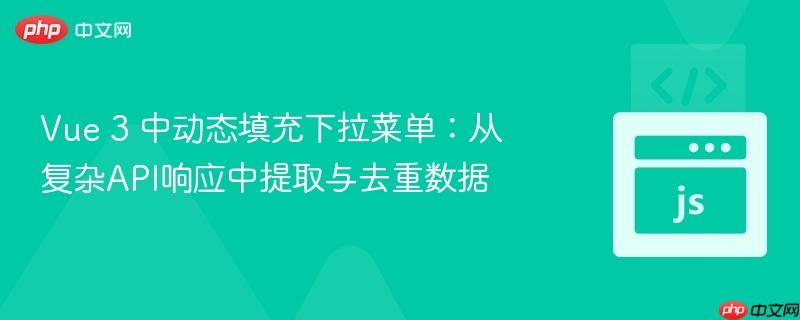
本文详细讲解了在Vue 3应用中,如何从复杂的API响应(通常是包含多个对象的数组)中提取并去重数据,以正确填充多个下拉选择框。文章通过分析常见错误,并提供使用`Array.prototype.map()`和`Set`进行数据转换的解决方案,确保下拉菜单能按预期显示数据。
在现代前端应用中,从后端API获取数据并将其展示在用户界面上是常见的需求。特别是在构建表单时,我们经常需要根据API返回的数据动态填充
开发者在处理这类场景时,常会遇到一个问题:尽管API成功返回了数据,但下拉菜单却未能按预期显示选项。这通常是由于对API返回数据结构的误解以及数据处理方式不当所导致。
考虑以下Vue 3组件的模板和脚本代码,它试图从一个API获取数据并填充三个下拉菜单:
立即学习“前端免费学习笔记(深入)”;
<template>
<div>
<div>当前下拉菜单数据概览: {{ dropdownData }}</div>
<select v-model="reason">
<option v-for="r in dropdownData.reasons" :value="r">{{ r }}</option>
</select>
<select v-model="condition">
<option v-for="c in dropdownData.conditions" :value="c">{{ c }}</option>
</select>
<select v-model="incidentType">
<option v-for="type in dropdownData.incidentTypes" :value="type">{{ type }}</option>
</select>
<button @click="getData">获取数据</button>
</div>
</template>
<script>
export default {
data() {
return {
reason: null,
condition: null,
incidentType: null,
dropdownData: {
reasons: [],
conditions: [],
incidentTypes: []
}
};
},
mounted() {
this.fetchDropdownData();
},
methods: {
fetchDropdownData() {
fetch(`${import.meta.env.VITE_API_VERBOSE}`)
.then((response) => {
if (!response.ok) {
throw new Error('Network response was not ok');
}
return response.json();
})
.then((data) => {
// 原始的错误数据赋值方式
this.dropdownData = {
reasons: [...data.reasons],
conditions: [...data.conditions],
incidentTypes: [...data.incidentTypes]
};
})
.catch((error) => {
console.error('Error:', error);
});
},
getData() {
// ...
}
}
};
</script>尽管API请求成功并返回了数据(例如,418条记录),但下拉菜单依然为空。问题的核心在于 fetchDropdownData 方法中的数据赋值逻辑:
this.dropdownData = {
reasons: [...data.reasons],
conditions: [...data.conditions],
incidentTypes: [...data.incidentTypes]
};如果API返回的数据 data 是一个包含多个事件记录的数组,例如:
[
{ "id": 1, "reason": "Accident", "condition": "Wet", "incidentType": "Collision" },
{ "id": 2, "reason": "Congestion", "condition": "Dry", "incidentType": "Traffic" },
{ "id": 3, "reason": "Accident", "condition": "Wet", "incidentType": "Collision" }
]那么 data.reasons、data.conditions 和 data.incidentTypes 都将是 undefined,因为 data 是一个数组,它没有名为 reasons、conditions 或 incidentTypes 的直接属性。因此,dropdownData 内部的数组将保持为空,导致下拉菜单无法渲染任何选项。
要正确填充下拉菜单,我们需要对API返回的原始数据进行转换和去重。
首先,通过浏览器开发者工具(Network Tab)检查API返回的实际数据结构至关重要。假设API返回的是一个事件记录的数组,每个记录都是一个对象,包含 reason、condition 和 incidentType 等属性。
我们需要遍历这个数组,从每个事件记录对象中提取出我们感兴趣的属性值(如 reason),并将它们收集到一个新的数组中。Array.prototype.map() 方法非常适合这个任务。
// 假设 data 是从 API 获取到的事件记录数组 const allReasons = data.map(item => item.reason); const allConditions = data.map(item => item.condition); const allIncidentTypes = data.map(item => item.incidentType);
此时,allReasons、allConditions 和 allIncidentTypes 数组可能包含重复的值。
下拉菜单通常只需要显示唯一的选项。我们可以使用 Set 对象来轻松去除数组中的重复值。Set 是一种只存储唯一值的集合。
const uniqueReasons = [...new Set(allReasons)]; const uniqueConditions = [...new Set(allConditions)]; const uniqueIncidentTypes = [...new Set(allIncidentTypes)];
这里,我们首先将包含重复值的数组转换为 Set,Set 会自动去除重复项。然后,使用扩展运算符 ... 将 Set 转换回一个新数组,这个数组只包含唯一的元素。
最后,将处理后的唯一数据赋值给 this.dropdownData,Vue 的响应式系统会自动更新视图。
this.dropdownData = {
reasons: uniqueReasons,
conditions: uniqueConditions,
incidentTypes: uniqueIncidentTypes
};结合上述数据处理逻辑,以下是修正后的Vue 3组件代码:
<template>
<div>
<h2>事件数据筛选</h2>
<p>当前下拉菜单数据概览: {{ dropdownData }}</p>
<div class="select-group">
<label for="reason-select">选择原因:</label>
<select id="reason-select" v-model="reason">
<option :value="null">-- 请选择原因 --</option>
<option v-for="r in dropdownData.reasons" :value="r" :key="r">{{ r }}</option>
</select>
</div>
<div class="select-group">
<label for="condition-select">选择条件:</label>
<select id="condition-select" v-model="condition">
<option :value="null">-- 请选择条件 --</option>
<option v-for="c in dropdownData.conditions" :value="c" :key="c">{{ c }}</option>
</select>
</div>
<div class="select-group">
<label for="incident-type-select">选择事件类型:</label>
<select id="incident-type-select" v-model="incidentType">
<option :value="null">-- 请选择事件类型 --</option>
<option v-for="type in dropdownData.incidentTypes" :value="type" :key="type">{{ type }}</option>
</select>
</div>
<button @click="getData">获取筛选数据</button>
</div>
</template>
<script>
export default {
data() {
return {
reason: null,
condition: null,
incidentType: null,
dropdownData: {
reasons: [],
conditions: [],
incidentTypes: []
}
};
},
mounted() {
this.fetchDropdownData();
},
methods: {
async fetchDropdownData() {
try {
// 使用 async/await 改进异步请求的可读性
const response = await fetch(`${import.meta.env.VITE_API_VERBOSE}`);
if (!response.ok) {
throw new Error(`网络响应错误: ${response.statusText} (${response.status})`);
}
const data = await response.json(); // data 现在是一个事件记录数组
// 提取并去重数据
const uniqueReasons = [...new Set(data.map(item => item.reason))];
const uniqueConditions = [...new Set(data.map(item => item.condition))];
const uniqueIncidentTypes = [...new Set(data.map(item => item.incidentType))];
// 更新 dropdownData
this.dropdownData = {
reasons: uniqueReasons,
conditions: uniqueConditions,
incidentTypes: uniqueIncidentTypes
};
} catch (error) {
console.error('获取下拉菜单数据时发生错误:', error);
// 可以在此处添加用户友好的错误提示,例如:
// this.errorMessage = '无法加载筛选数据,请稍后再试。';
}
},
getData() {
// 根据选定的值 (this.reason, this.condition, this.incidentType) 执行进一步操作
console.log('选定的原因:', this.reason);
console.log('选定的条件:', this.condition);
console.log('选定的事件类型:', this.incidentType);
// 例如,可以根据这些值发起另一个API请求来筛选事件数据
}
}
};
</script>
<style scoped>
/* 示例样式,提高可读性 */
.select-group {
margin-bottom: 15px;
}
.select-group label {
display: block;
margin-bottom: 5px;
font-weight: bold;
}
.select-group select {
padding: 8px;
border: 1px solid #ccc;
border-radius: 4px;
width: 200px;
}
button {
padding: 10px 15px;
background-color: #007bff;
color: white;
border: none;
border-radius: 4px;
cursor: pointer;
margin-top: 10px;
}
button:hover {
background-color: #0056b3;
}
</style>在Vue 3应用中动态填充下拉菜单时,理解API返回的数据结构并进行适当的数据预处理至关重要。通过灵活运用 Array.prototype.map() 方法提取所需属性,并结合 Set 对象进行数据去重,我们可以高效、准确地从复杂的API响应中生成适用于下拉菜单的唯一选项。遵循本文介绍的最佳实践,将有助于构建健壮、用户友好的数据驱动型前端应用。
以上就是Vue 3 中动态填充下拉菜单:从复杂API响应中提取与去重数据的详细内容,更多请关注php中文网其它相关文章!

每个人都需要一台速度更快、更稳定的 PC。随着时间的推移,垃圾文件、旧注册表数据和不必要的后台进程会占用资源并降低性能。幸运的是,许多工具可以让 Windows 保持平稳运行。

Copyright 2014-2025 https://www.php.cn/ All Rights Reserved | php.cn | 湘ICP备2023035733号